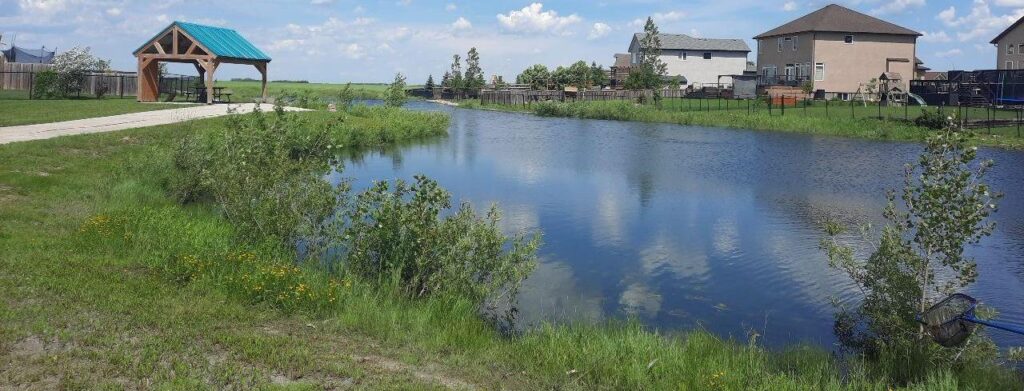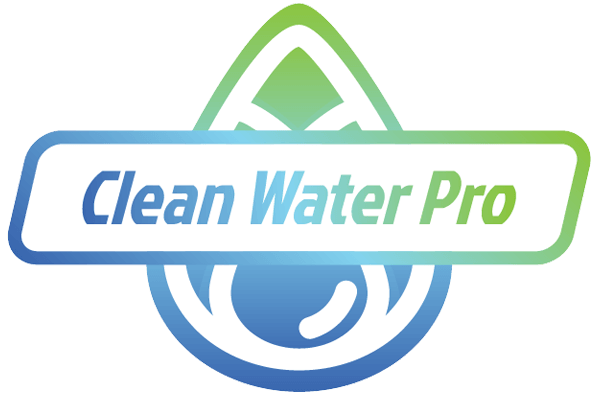Introduction: Components Of A Healthy Pond Ecosystem
Although not a living organism, storm retention ponds are regarded as thriving ecosystems supporting diverse aquatic life forms and maintaining excellent water quality. To understand the significance of a healthy pond ecosystem, let’s explore its various components and ecological processes.

- Biotic Components: Ponds harbour many living organisms, including plants, algae, bacteria, fungi, insects, fish, amphibians, and other aquatic animals. These organisms interact with one another and their environment, establishing complex ecological relationships that contribute to the overall balance of the ecosystem.
- Oxygenation: Aquatic plants, including submerged weeds, oxygenate the pond. These plants produce oxygen through photosynthesis, enriching the water with dissolved oxygen. Maintaining optimal dissolved oxygen levels is vital for the respiration of fish and other aquatic organisms residing in the pond.
- Nutrient Cycling: Ponds are dynamic systems where various nutrient cycles occur. Plants and algae utilize nutrients such as nitrogen and phosphorus for growth. When these organisms die, bacteria and fungi decompose, releasing nutrients into the water. This nutrient cycling process fuels the development of new organisms and is essential for the pond’s ecological processes. However, excessive nutrient loads can lead to problems.
- Response to Environmental Changes: Ponds can respond to environmental changes such as temperature fluctuations, rainfall patterns, and nutrient availability. These changes can influence the composition and behaviour of the organisms present in the pond, shaping its overall ecological dynamics.
Let’s Talk About Runoff Into Storm Retention Ponds!
Runoff can significantly impact the water quality of a pond. Runoff refers to the flow of water and any substances it carries from the land into a pond. Here are some ways in which runoff can affect pond water quality:
- Sedimentation: Runoff can carry soil particles, silt, and other suspended solids into the pond. These sediments can settle at the bottom of the pond, causing turbidity and reducing water clarity. Excessive sedimentation can smother aquatic plants, block sunlight, and negatively impact the habitat of aquatic organisms.
- Nutrient influx: Agricultural runoff or runoff from urban areas often contains high levels of nutrients, such as nitrogen and phosphorus, from fertilizers, sewage, or animal waste. These nutrients can lead to eutrophication, an overabundance of nutrients in the water, which promotes the growth of algae and other aquatic plants. Excessive algae growth can deplete oxygen levels in the water, leading to fish kills and other negative impacts on aquatic life.
- Chemical contaminants: Runoff can transport various chemicals from the land into the pond, including pesticides, herbicides, fertilizers, and pollutants from streets and parking lots. These contaminants can harm aquatic organisms and disrupt the pond’s ecological balance. They may also pose risks to human health if the pond is used for recreational purposes.
- Temperature changes: Runoff can alter the temperature of pond water. For example, runoff from urban areas can carry heated water from roads and parking lots, leading to increased water temperature in the pond. Drastic temperature changes can stress or harm aquatic organisms sensitive to temperature fluctuations. Warmer water does not hold dissolved oxygen as cooler water and dissolved oxygen levels deplete more readily.
- Pathogens and bacteria: Runoff from agricultural areas or areas with inadequate sewage treatment, pet waste & goose populations can contain pathogens, bacteria, and other microorganisms. These contaminants can pose health risks to aquatic organisms and humans who come into contact with the water.
It is important to implement appropriate land management practices to mitigate the negative effects of runoff on pond water quality, such as erosion control measures, avoiding fertilizing around the pond, discouraging goose presence, cleaning up pet waste, and not dumping waste in the pond and riparian buffers.
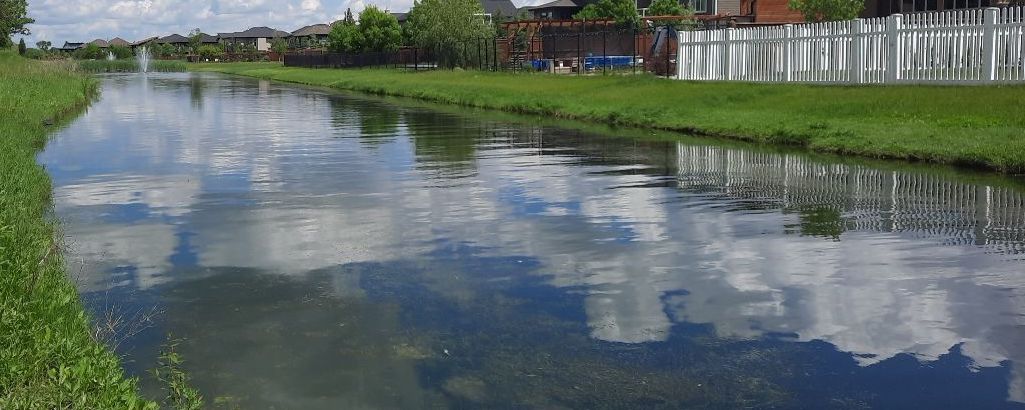
City Retention Pond vs. Backyard Dugout Pond
When managing and remediating a backyard dugout versus a storm retention pond, key factors make remediation more challenging in storm retention ponds.
Here are some key factors to consider:
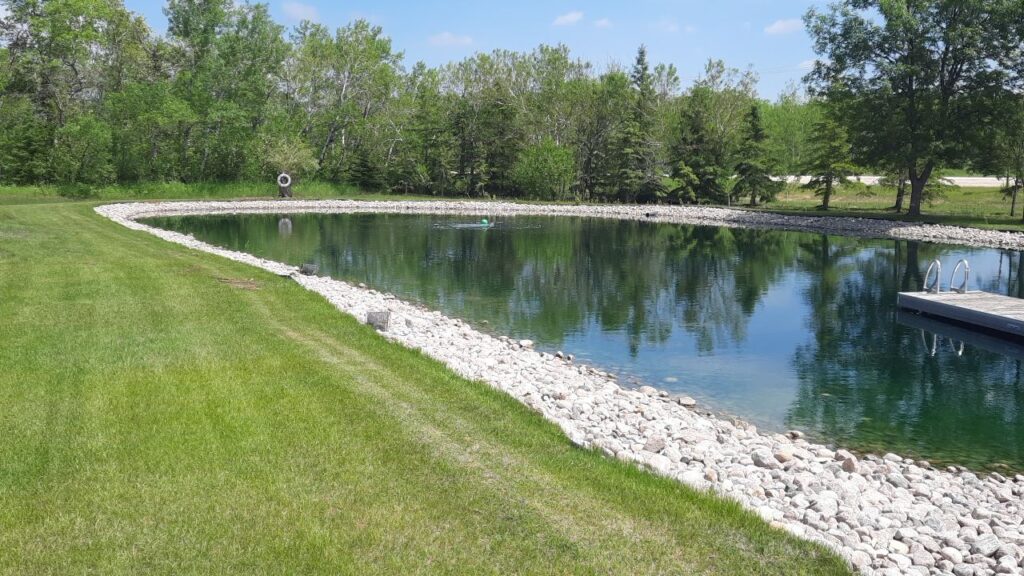
- Purpose: Understand the intended purpose of the dugout or storm retention pond. A backyard dugout is typically designed for aesthetic appeal and recreation. In contrast, a storm retention pond is primarily constructed to collect and manage stormwater runoff within a residential or commercial landscape.
- Water Quality Entering the Ponds: Typically, a backyard dugout will have fewer pollutants and nutrients entering the pond than the water entering a storm retention pond setting. The water entering a storm retention pond may contain fertilized nutrients from the residential landscape, chlorinated pool water from backyard residential pools, and oil/gasoline from streets and parking lots that drain into the ponds.
Challenges in Maintaining City Storm Retention Ponds:
City storm retention ponds present unique challenges in establishing and maintaining a healthy ecosystem compared to typical backyard ponds. Three primary issues arise:
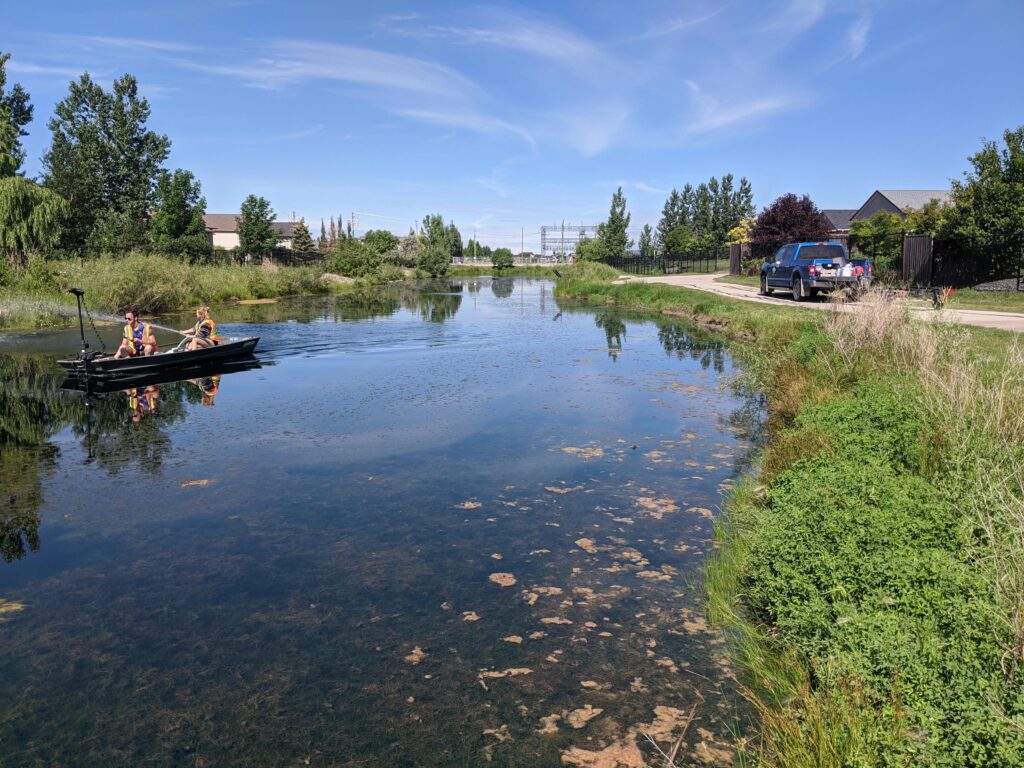
- Water Quality Issues: Storm retention ponds often receive runoff from roads, parking lots, and residential landscapes, carrying pollutants such as oil, heavy metals, pesticides, fertilizers, and contaminants. These pollutants can degrade water quality and threaten aquatic life and human health if not managed and treated properly.
- Algal Blooms: Excessive nutrient runoff from farm fields and residential areas, particularly high levels of phosphorus and nitrogen, can lead to the proliferation of algae in retention ponds. Algal blooms can deplete oxygen levels, causing fish kills and the production of harmful toxins that are detrimental to aquatic life and human well-being.
- Inappropriate Pollutant Dumping: The improper disposal of pollutants such as fire pit ashes, compost, paint, oil, and other substances further complicates the management of these ponds, contributing to their challenges.
Clean Water Pro’s Approach to Addressing Concerns:
We have developed a comprehensive management program at Clean Water Pro to mitigate these concerns. Our approach includes regular maintenance, water quality monitoring, and the application of ecologically friendly treatments that address high nutrient loads without harming the pond’s inhabitants.
Over the years, we have witnessed an increase in pollution-sensitive species, indicating the improved health of the ponds under our management. We effectively control algae growth, enhance oxygen levels through aeration, and promote diverse species within and around the pond, fostering a thriving ecosystem.
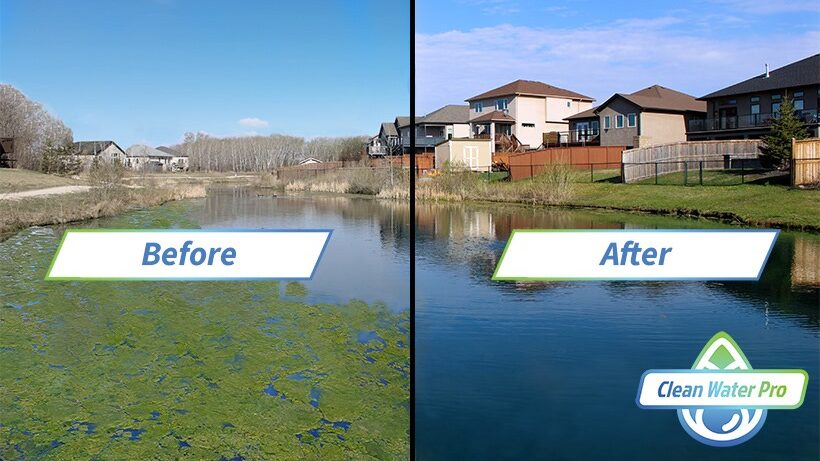
The Presence of Aquatic Weeds in Ponds
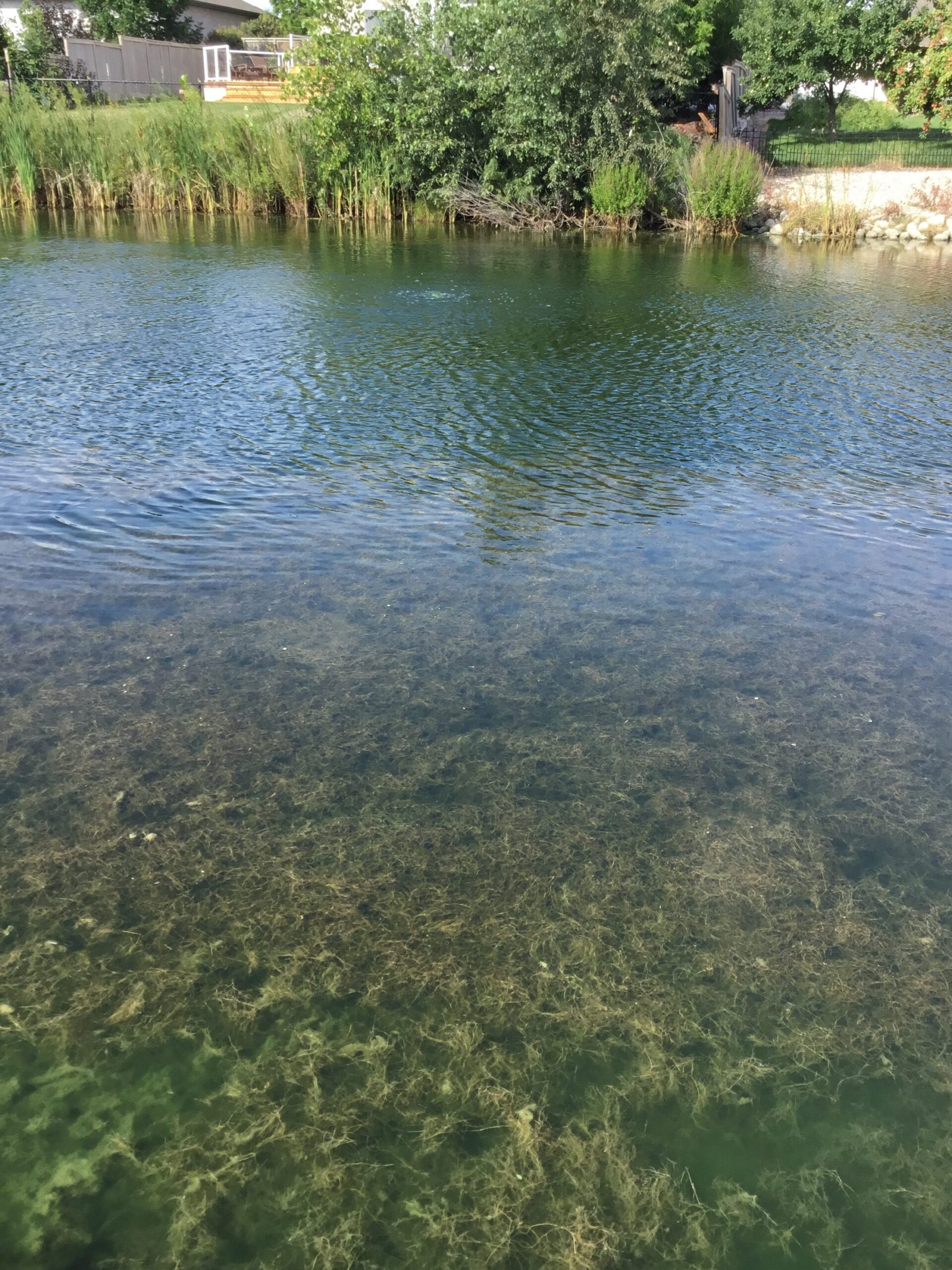
Submerged aquatic weeds naturally occur in ponds due to several factors. The water depth and substrate provide favourable conditions for their growth.
Ponds with relatively shallow depths allow sunlight to penetrate the water, facilitating photosynthesis in aquatic weeds. Furthermore, the nutrient-rich muck accumulation at the pond’s bottom is an ideal root bed for these plants to thrive.
Although they may be considered visually unappealing, aquatic weeds offer various benefits to the pond ecosystem:
- Essential Habitat and Shelter: Submerged weeds provide vital habitat and shelter for numerous aquatic organisms, including fish, invertebrates, amphibians, and other creatures. They serve as refuge areas, spawning grounds, and food sources, contributing to the pond’s overall biodiversity and ecological balance.
- Oxygenation and Water Quality: Submerged aquatic weeds oxygenate the water through photosynthesis, releasing oxygen as a byproduct. This oxygen enrichment benefits fish and other aquatic organisms. Additionally, these plants help improve water clarity by absorbing excess nutrients, such as nitrogen and phosphorus, thereby reducing algae growth and enhancing water quality. Moreover, the root systems of submerged plants aid in stabilizing sediment and preventing erosion along the pond’s shoreline.
By understanding the ecological significance of aquatic weeds and their positive contributions to the pond ecosystem, we can appreciate their role in maintaining a healthy and balanced environment. By implementing effective management strategies, addressing water quality issues, mitigating algal blooms, and embracing the benefits of aquatic weeds, we can ensure the long-term health and sustainability of ponds, particularly in challenging settings like city storm retention ponds.
Residents Living Near A Storm Retention Pond: What Can You Do To Help?
If you live beside a storm retention pond and want to improve its functionality and appearance, there are several steps you can take as a homeowner. Here are some suggestions:
- Maintain the shoreline: Keep the area around the pond clean and debris-free. Regularly remove litter, fallen branches, or other objects obstructing the pond or its inlet/outlet structures. Avoid using harmful chemicals or fertilizers near the pond to prevent pollution.
- Plant native vegetation to create a buffer zone: Establishing a natural buffer zone between your property and the pond by planting native plants around the pond can help stabilize the shoreline, prevent erosion, and improve water quality. Native plants are adapted to the local climate and require less maintenance. They also provide habitat for wildlife. Avoid using cattails or bullrushes as they promote duckweed growth. Always check with local authorities before planting.
- Consider wildlife enhancements: Retention ponds can support various forms of wildlife. Installing birdhouses, bat boxes, or pollinator gardens around the pond can attract beneficial species and promote biodiversity. However, ensure these enhancements do not interfere with the pond’s primary function or disrupt its natural processes. Check with local authorities to ensure you are permitted.
- Engage with your community: Coordinate efforts with your neighbours and local community groups to improve the storm retention pond collectively. Reducing pollutants like waste, fertilizers, pool water, etc., from entering the pond, developing a riparian zone, and encouraging biodiversity all positively impact the pond.
Remember to check with your local municipality before implementing any changes to ensure compliance with regulations and guidelines.
